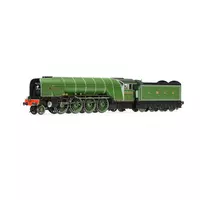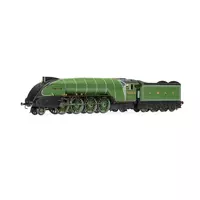Manufacturer catalogue image - please note that pre-release images may be CAD renders or CGI images rather than photographs
Prototype Eras
Era 3 (1923 to 1947) The Big Four (LNER, LMS, GWR and SR)
Era 11 (2016 to 2025) Current Era
Manufacturer description
The London and North Eastern Railway (LNER) Edinburgh to Aberdeen route had steep gradients and tight curves and the express passenger service was usually worked by a double header of two small engines. To overcome this situation, Nigel Gresley, Chief Mechanical Engineer (CME) of the LNER began designing a new locomotive at the LNER Doncaster Works in 1932.
The 2-8-2 configured locomotive was given the classification P2 and had four driving axles for greater adhesion, an A3 type boiler and a Kylchap type blastpipe/chimney system. A total of six of the Class were built. As the first two were returned to Doncaster for repairs they were fitted with streamlined fronts similar to the A4 Pacifics. The last four to be built were outshopped with streamlined fronts.
By 1944 the whole Class had been withdrawn. The 'A1 Trust', builders of the A1 locomotive 'Tornado', are currently in the process of building a continuation of the P2 class; 2007 'Prince of Wales'. Whilst this locomotive will be based off of 2001 'Cock o' the North', 2007 will incorporate some changes such as sharing a boiler design with A1 'Tornado' and incorporating an improved pony truck design.
Produced under license for SCMG Enterprises Ltd. ©SCMGE.
Catalogue listing
Model details
Prototype information
* Class names often change over the lifespan of a locomotive, so this is not necessarily the class name used by the operator in the period modelled.
Supplier links are provided for your convenience and do not guarantee that the product is currently available. RailwayModels.uk is not a representative of these suppliers, but may receive a commission when purchases are made through links on this page.







